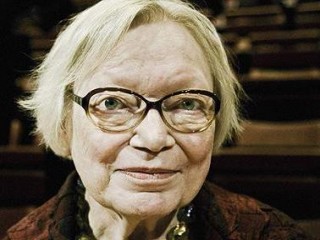
Inger Christensen biography
Date of birth : 1935-01-16
Date of death : 2009-01-02
Birthplace : Vejle, Denmark
Nationality : Danish
Category : Famous Figures
Last modified : 2011-10-06
Credited as : poet, novelist,
0 votes so far
Inger Christensen was born in the town of Vejle on the eastern coast of Jutland. Her father, Adolf Emanuel Christensen, was a tailor. After graduating from Vejle Gymnasium in 1954, Christensen moved to Copenhagen, enrolling in medical school, but later withdrew for financial reasons. She then went to Århus, where she studied at Teachers' College, receiving her teacher certificate in 1958. During this period, she published poems in the journal Hvedekorn. The poet and critic Poul Borum (1934-1996), whom she married in 1959, guided her early writing. Christensen and Borum divorced in 1976.
After working at the College for Arts in Holbaek in 1963-1964, Christensen devoted herself entirely to writing. Her first collections of poems, Lys (1962) and Græs (1963), examined creativity, self-knowledge, and the function of the language. Also ordinary language philosophy has left traces in her work. In 1964 Christensen became a full-time writer. Her major work from this decade was det (1969), which reflected at one level contemporary aesthetic, social and political topics, but innermostly explored existential questions. In the chantlike poem 'The Action: symmetries' Christensen wrote: "Society can be so petrified / That's it's all one solid block / Inhabitants so ossified / That life's in a state of shock". (trans. by Sheila La Farge)
In her novels Christiansen also dealt with creativity, fiction, and reality. Det malede værelse (1976) was about the Italian Renaissance painter Andrea Mantegna, who combined harmony and spatial illusion with mathematical precision. The novel had three different narrators. At the end, the barrier between world and its picture eventually crossed and reality and imagination are thus integrated.
Christensen's book length poem Alfabet (1981), twice translated into Swedish, is the most famous Danish example of the so-called "systemic" poetry (systemdigtning), "arbitrary systems structure expressions themselves constructed like machines, understanding their own relativity in constructions which merely repeat themselves." (from History of European Literature by Annick Benoit-Dusausoy et al, 2000) The poem was formally structured around alphabets from "a" (apricot trees) to "n" (nights) and on the Fibonacci (c. 1170-c. 1250) sequence (0, 1, 1, 2, 3, 5, 8, 13, 21, 34...), in which every term is the sum of the two previous ones (0+1=1, 1+1=2, 1+2=3, 2+3=5...). Another famous example of combining systematic thought with poetry is Primo Levi's The Periodic Table (1975), which contrasted the Russian chemist Mendeleyev's periodical table of elements with autobiographical meditations. "The numerical rations exist in nature," Christensen once explained, "the way a leek wraps around itself from the inside, and the head of a sunflower, are both based on this series." The ninth alphabet is "i", and subsequently Christensen started the section with the word "ice" (in Danish "is") – "ice ages exist, ice ages exist, ice of polar seas, kingfishers' ice". The system ends with the letter "n", which has several meanings, including the case in which "n" is the symbol for the set of natural numbers.
Christensen contributed to such magazines as Krise og Utopi and Chancen, wrote children's book and a number of radio and television plays which have been produced in several countries. Christensen's poems have been set to music by the Danish composers Ib Nørholm and Svend Nielsen. She received numerous prizes, including the Nordic Prize of the Swedish Academy (1994), Der österreichische Staatspreis für Literature (1994), Grand Prix des Biennales Internationales de Poésie (1995), and Edvard Pedersens Biblioteksfonds Forfatterpris in 2003. In 1978 Christensen was appointed in the Danish Academy and in 1995 she become a member of Académie Européenne de Poésie. She was frequently mentioned as a candidate for the Nobel Prize in literature. Christensen died after a short illness in Copenhagen on January 2, 2009.
Author of books:
Lys: digte, 1962
Græs: digte, 1963
Evighedsmaskinen, 1964
Azorno, 1967 - Azorno (tr. by Denise Newman)
det, 1969 - it (tr. by Susanna Nied)
Intriganterne, 1972 (play)
Det malede værelse, 1976 - The Painted Room: A Tale of Mantua (tr. by Denise Newman)
Brev i april, 1979
Den historie der skal fortælles, 1979
Alfabet, 1981 - Alphabet (tr. by Susanna Nied)
Del af labyrinten, 1982 (essays)
Den store ukendte rejse, 1982
En vinteraften i Ufa og andre spil, 1987 (plays)
Digte, 1988
Lys og Græs, 1989
Mikkel og hele menageriet, 1990 (illustrated by Lillian Brøgger)
Sommerfugledalen, 1991 - Butterfly Valley: A Requiem (tr. by Susanna Nied)
Samlede digte, 1998
Hemmelighedstilstanden, 2000.



















